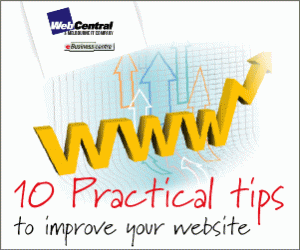 So you had this great idea to sell your product or service online, you looked around, got a few quotes and found a clever bunch of people (they seemed technical!), they built the site for you and then you launched. But then you had trouble convincing your customers to buy online from you. So how can you make the most of your online business to grow sales and keep the customers coming back again and again?
So you had this great idea to sell your product or service online, you looked around, got a few quotes and found a clever bunch of people (they seemed technical!), they built the site for you and then you launched. But then you had trouble convincing your customers to buy online from you. So how can you make the most of your online business to grow sales and keep the customers coming back again and again?
Unfortunately for many sites there is no Kevin Costner ending, this is no Field of Dreams. You may have built it and but they are just not coming. What has gone wrong? How can you make the most of your new asset?
The first thing to do is get into the right mindset to run an online business. If it was a retail store at your local mall you would plan the store layout, have inviting signage, endeavour to make potential customers feel comfortable and generally provide an appealing place to be. This has to be done online as well. The number of online businesses that merely cobble something together, skimp on budgets and generally present badly is staggering. This is even the case in some online offerings where online is the only channel that the product is sold. Online is cost-effective compared with offline but it is not a freebie. The more you invest in your online business the better the results.
The problem can usually be split into two areas: a lack of sales from those who find your site, and no one actually coming to the site.
Site not converting – lack of sales
Although you have reasonable traffic levels you find that you just aren’t closing the sale. People are looking in your shop but not buying. Why is this?
The rapid increase in internet access has of course led to an increase in online purchases but not everyone is comfortable with making purchases online. There is still a fear factor in the community. Is this fear justified? Yes and no. Can it be addressed? Absolutely it can. The four main areas of concern in online purchases are security, delivery, quality and privacy.
Security
The single biggest worry in the online purchase community is security and what happens to credit card numbers and who has access to personal details. The fact that the people with these worries are the same ones who will happily hand their credit card to a waiter at a restaurant who then disappears out the back with the keys to the kingdom is of no consequence if you can’t get them to part with their information online.
Starting at the top of the tree, the best method—for both customer and seller—is a bank’s payment gateway or a third party payment gateway, such as Paypal. This method is best for the client as no credit card details are stored and everything is fully encrypted. It is also superior for the supplier as not only are the credit card details validated but also the capacity to pay is all done in real time.

The next step down is called a secure socket layer (SSL) which is a method where data is entered on a front end form, encrypted in the transfer process and fed down to a backend database. During the transfer a little padlock will appear on the browser which means that the data cannot be read by any external hackers or programs. There are different methods of implementing SSL and each method gives rise to their own pros and cons. However, the best method is to buy a dedicated SSL. This means that you will be able to secure your whole domain by redirecting your non-secure domain to your secure one, enabling full protection for the user. This method typically avoids the message “You are now entering a secure part of the site,” and, more importantly, the one after completing a transaction “You are now entering a non-secure part of the site.” These messages can cause (unfounded) worry and confusion and it is this worry that major companies—such as banks—aim to alleviate by using dedicated SSL hosting. The only con to hosting a dedicated SSL is the cost. It will set you back $1500 for set-up and $750 a year thereafter.
Shared SSL gives all the security of dedicated SSL but the perception of full security is lost when a customer moves from unsecured areas of your site to secure areas—the payment form—because the domain name changes. Although this may seem minor but there is significant industry data which shows the high number of customers that drop out of a purchase on a shared SSL as opposed to a dedicated SSL. The financial aspect of a shared SSL is the real draw card with prices of around $25 a month being commonplace.
Finally, non-secured data transfer, including emailing of form contents, is the last method used. The use of these methods is still amazingly high. Put simply you are asking your client to write the details down on a piece of paper and post it in a clear plastic sleeve. The consequences can be dire and such a method can never really be justified.
Delivery
The ability to deliver product is also a concern to customers especially if your physical address is a significant difference from where they purchased the product online. Most of these fears can be put to rest by simply partnering with a reliable delivery company and then clearly telling the customers of your deliver information and any associated guarantees you are prepared to make.
Quality
Unfortunately many customers still hold the belief that online merchandise consists of off-cuts, factory seconds or inferior quality stock. Addressing this fear can be as simple as reassuring customers of the product warranties together with a solid reinforcing statement as to the quality of the provided stock.
Privacy
In addition to concerns of how credit card information will be used, many users have concerns over how their basic details (name, address email) will be used. By providing continual clear links to your privacy policy as well as adding statements such as ‘Privacy is important to us’ on all data collection pages, reassures users making them comfortable in handing over their personal info.
No one visiting
Above the line businesses run advertising campaigns and if the ads are effective people will generally buy the product. Online is pretty much the same except it has the added benefit of a different form of media – search.
While there is validity in online advertising such as banners for filling the role of more traditional media (top of mind, awareness) the low click through rates for such activity have scared a lot of customers away from this medium.
It should be noted that there are many ways to pay for banner advertising including performance. Performance campaigns are ones in which payments for banner advertising is based on whether a user actually clicks on the banner (Cost per click CPC) and in some cases can extend to payment but only if a user subsequently performs a defined action on your site (Cost per acquisition CPA).
In relation to search, there are two key areas SEM and SEO. SEM is search engine marketing and is simply a method of paying for position on search results within the sponsored areas. Payment is based on a CPC basis however the quality of the destination pages (how relevant the result page is to the search term) and the click through rate for your advertisement can significantly reduce the CPC and dramatically increase the effectiveness of your spend.
SEO is search engine optimisation which focuses on improving your ranking in natural (non-sponsored) searches. For many businesses using search terms are particularly hard to win but if you take the time to engage a digital agency with full SEO capabilities , they will be able to analyse what people are searching for and how to best grab the most users for the least cost. It should be noted that SEO activities are the most costly as they need ongoing attention. The flip side is that SEO’s have the most benefit. If your business is online winning the Google war then you are well on your way to driving traffic to your site.
—James Ward is CEO of Freestyle Media (www.freestylemedia.com.au), which specialises in driving traffic to websites and converts online customers into purchasers of products and services.
People who read this, also liked:
10 tips for online business success
How to make the most of your business website
Seeking to promote your business? Create your free Australian business listing with Dynamic Search business directory – Sister site of Dynamic Business.
